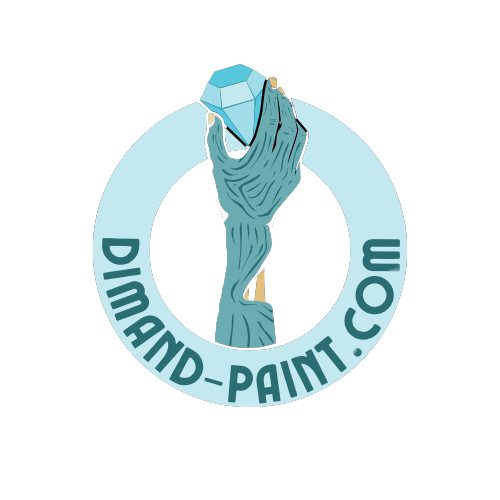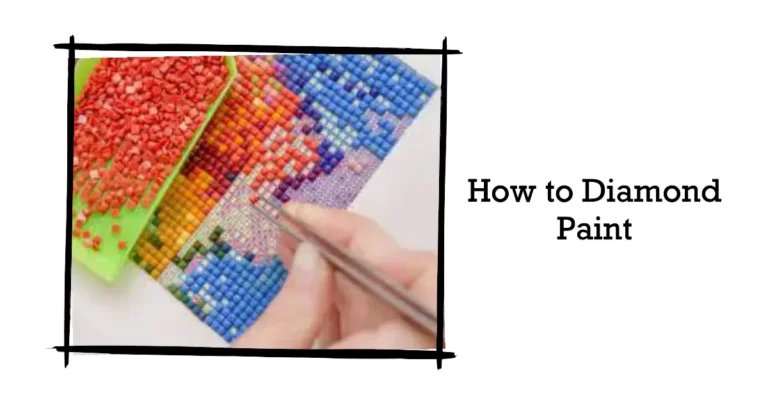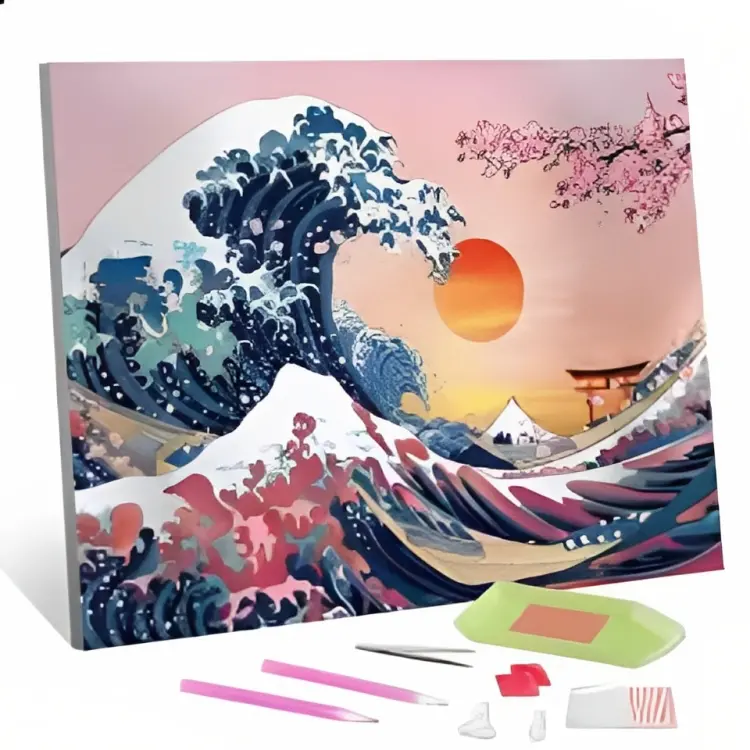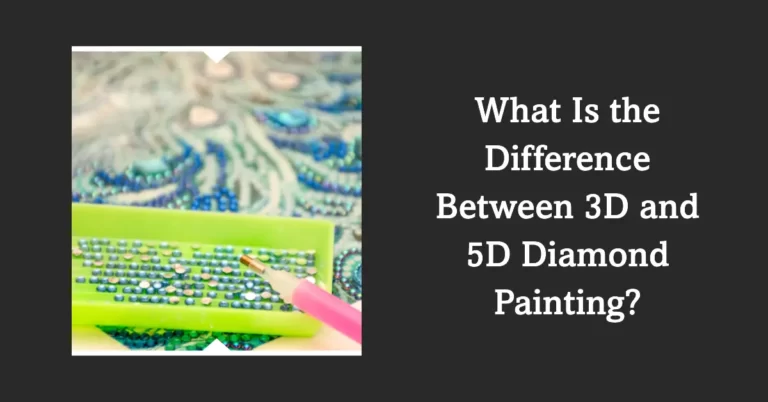Round vs Square Diamond Painting: Which is Better?
Diamond painting has gained immense popularity as a creative and therapeutic hobby. The process involves placing tiny beads, known as drills, onto a canvas to create a stunning piece of art.
However, when it comes to diamond painting, one of the common debates among enthusiasts revolves around the choice between round and square drills. In this article, we will delve into the characteristics, advantages, and considerations associated with round and square drills to help you make an informed decision.
Understanding Round Drills
Round drills are the go-to choice for many beginners in the diamond painting world. These drills have a circular shape and are slightly larger than their square counterparts.
The larger size and rounded edges make them easier to pick up and place on the canvas. One of the notable features of round drills is their ability to create a sparkling effect due to the increased number of facets on the surface. This sparkle often resembles that of glitter, adding a touch of magic to the artwork.
While round drills offer simplicity and a quicker painting process, they do come with a few considerations. Since the drills have no corners, visible gaps exist between them when placed on the canvas.
However, these gaps are generally not noticeable when viewing the painting from a distance. To ensure the longevity and cleanliness of the artwork, many diamond painters choose to seal round drill paintings after completion.
Exploring Square Drills
Square drills, on the other hand, are the preferred choice for more experienced diamond painters. These drills have a square shape and fit together neatly without any visible gaps.
The resulting image appears fuller and more complete, thanks to the precise alignment of the square drills. Square drills have a glossy shine that adds sophistication to the artwork.
Due to their smaller size compared to round drills, square drills offer higher resolution. You can fit more square drills into a smaller area, allowing for intricate details and sharper lines. However, the smaller size can pose a challenge for individuals who find working with tiny drills difficult, such as older painters or those with shaky hands.
Despite this, many diamond painters enjoy the satisfying “snap” sound that square drills make when filling in the gaps, comparing it to popping bubble wrap.
Skill Level and Personal Preference
When deciding between round and square drills, your skill level and personal preference play significant roles. Round drills are often recommended for beginners due to their ease of use and forgiving nature.
The larger size and forgiving placement make them an excellent choice for those new to diamond painting or seeking a relaxing and straightforward project. Additionally, the sparkle effect created by round drills can be visually appealing and captivating.
On the other hand, square drills are well-suited for experienced diamond painters who enjoy a challenge and strive for precision. If you have prior experience with other crafts or feel confident in your artistic abilities, square drills can provide an opportunity to push your skills further. T
he neatness, sharp lines, and mosaic-like appearance created by square drills can result in a visually stunning finished piece.
It’s essential to consider your comfort level and the level of challenge you desire. While round drills may be more accessible, don’t be afraid to explore square drills if you’re up for a rewarding artistic journey.
Time and Completion Factors
The choice between round and square drills can also be influenced by the time you have available and the desired level of detail in your project. Round drills are generally quicker to place on the canvas due to their larger size and ease of application.
If you’re looking to complete a project efficiently or have limited time to dedicate to diamond painting, round drills might be the better option.
Square drills, on the other hand, require more time and precision. The smaller size of square drills allows for finer details and a higher level of intricacy in the artwork. If you enjoy immersing yourself in the creative process and are willing to invest more time and effort, square drills can offer a rewarding experience with remarkable results.
Consider your schedule, artistic goals, and desired level of intricacy when choosing between the two drill shapes.
Visual Appeal and Aesthetics
The choice of drill shape can significantly impact the visual appeal and aesthetics of a diamond painting. Round and square drills create distinct looks that cater to different preferences.
Round drills, with their sparkling effect and slightly larger size, produce a result that resembles a mosaic filled with shimmering dots. The sparkle adds a touch of whimsy and can create an eye-catching effect when viewed from different angles.
Round drill paintings often have a softer and more organic appearance, making them suitable for various subjects, such as landscapes, animals, and portraits.
Square drills, with their sharp edges and precise alignment, offer a more structured and polished look. The absence of gaps between the drills creates a seamless image that closely resembles a pixelated artwork.
Square drill paintings excel in capturing intricate details and creating a clean, professional finish. They are particularly well-suited for subjects that require precise lines and geometric patterns.
Ultimately, the visual appeal and aesthetics of diamond paintings are subjective and depend on individual preferences. Some may prefer the enchanting sparkle of round drills, while others gravitate towards the refined elegance of square drills.
Ease of Application and Maintenance
The ease of application and maintenance is another aspect to consider when choosing between round and square drills. Round drills are generally easier to pick up with the diamond pen and faster to place on the canvas due to their rounded shape.
The forgiving nature of round drills means that slight placement errors or gaps between drills are less noticeable when viewed from a distance. However, it’s important to seal round drill paintings after completion to prevent dust and debris from adhering to the exposed adhesive.
Square drills, while requiring more precision during application, offer the advantage of a satisfying “snap” when placed in the designated area. The precise alignment of square drills creates a visually appealing and neat image without any visible gaps.
Maintaining square drill paintings is relatively easier due to the absence of exposed adhesive and the even surface. However, the smaller size of square drills can make them slightly more challenging to handle, especially for individuals with limited dexterity.
Consider your comfort level and the level of precision you desire when deciding between round and square drills.
If you enjoy the gratifying sound of snapping drills and have confidence in your ability to work with smaller pieces, square drills can provide a rewarding experience.
Testimonials and User Experiences
To provide a broader perspective on the debate between round and square drills, let’s explore the testimonials and experiences of diamond painters who have worked with both drill shapes.
Many diamond painters who prefer round drills emphasize the ease of use and faster completion times. They appreciate the forgiving nature of round drills, especially when working on larger canvases or subjects with intricate color variations.
The sparkling effect created by round drills adds a touch of magic to their artwork and enhances the overall visual appeal. Some painters also find round drills more comfortable to handle, particularly if they have arthritis or other hand mobility issues.
Conversely, enthusiasts who favor square drills appreciate the precision and sharpness they offer. They enjoy the challenge and attention to detail that comes with working on smaller and more intricate designs.
The satisfaction derived from achieving a seamless, pixelated image without any visible gaps is a common sentiment among square drill enthusiasts. They often compare the experience to solving a puzzle and find it deeply satisfying.
It’s important to note that individual preferences can vary, and what works for one person may not be the same for another. Some diamond painters find joy in using both round and square drills, depending on the project or their mood.
Experimentation and personal exploration are encouraged to discover your own preferred drill shape.
Popular Trends and Preferences
The diamond painting community is dynamic, with various trends and preferences emerging over time. While both round and square drills have their devoted fans, it’s worth exploring the current trends to gain a broader understanding of the community’s preferences.
At present, square drills have gained significant popularity among experienced diamond painters. Many artists and collectors gravitate towards square drill paintings for their refined look and intricate detailing.
The clean lines and precise alignment of square drills lend themselves well to subjects such as cityscapes, mandalas, and geometric patterns. The challenge and satisfaction of working with square drills have become a sought-after aspect of the hobby.
However, it’s important to note that round drills continue to hold their own charm and appeal. The sparkling effect and softer appearance of round drill paintings resonate with many diamond painters who prefer subjects like landscapes, flowers, and fantasy-themed art.
Round drills also remain popular among beginners and individuals who seek a more relaxing and forgiving diamond painting experience.
The diamond painting community is diverse, and preferences can vary greatly from person to person. It’s crucial to choose a drill shape that aligns with your artistic goals, skill level, and personal aesthetic preferences.
Tips for Maximizing Results
Regardless of whether you choose round or square drills, there are several tips and techniques that can help you achieve the best results in your diamond painting projects. Here are some valuable tips to consider:
- Prepare your workspace: Set up a clean and well-lit workspace where you can comfortably work on your diamond painting project. Adequate lighting ensures accurate color selection and proper placement of drills.
- Organize your drills: Before you begin, organize your drills in a way that allows easy access and prevents them from getting mixed up. Use storage containers, labeling, or a diamond painting accessories kit to keep your drills organized.
- Start from the center: Begin placing drills on the canvas from the center and work your way outwards. This helps maintain symmetry and prevents the canvas from warping.
- Use a multi-placer tool: A multi-placer tool allows you to place multiple drills at once, saving time and ensuring consistent alignment. This tool is particularly useful when working with round drills.
- Apply gentle pressure: When placing drills, apply gentle pressure to secure them onto the canvas. Avoid pressing too hard, as it may distort the canvas or cause neighboring drills to shift.
- Check for air bubbles: After placing drills, carefully inspect the canvas for any air bubbles trapped beneath the drills. Gently press on the bubble to release the trapped air and flatten the drill.
- Seal your artwork: To protect your diamond painting and enhance its longevity, consider sealing the finished artwork. Apply a suitable sealer or varnish according to the manufacturer’s instructions.
- Take breaks: Diamond painting can be a time-consuming activity, so remember to take breaks to rest your eyes, hands, and mind. This will help maintain focus and prevent fatigue.
By following these tips and techniques, you can enhance your diamond painting experience and achieve beautiful, professional-looking results.
Impact of Drill Shape on Artistic Expression
The choice of drill shape, whether round or square, can significantly influence the level of artistic expression in your diamond paintings. The unique characteristics of each drill shape provide different opportunities and challenges for artists to explore.
Round drills, with their sparkling effect and softer appearance, are well-suited for creating a dreamy and whimsical atmosphere in artwork.
They lend themselves well to subjects that require a more organic and natural feel, such as landscapes, animals, and floral designs. The ability of round drills to capture light and reflect sparkle can add an enchanting quality to your creations.
On the other hand, square drills offer a precise and structured approach to artistic expression. The sharp edges and neat alignment of square drills allow for the creation of geometric patterns, architectural details, and intricate designs.
Artists who enjoy working with symmetry, straight lines, and sharp angles will find square drills to be a versatile tool for their artistic vision.
It’s worth mentioning that the choice of drill shape should not limit your creativity. Some artists embrace the challenge of combining both round and square drills in a single artwork, creating a visually dynamic and captivating piece.
The interplay between the two drill shapes can add depth and dimension to the artwork, making it truly unique.
Conclusion
In the debate of round versus square drills in diamond painting, there is no definitive answer as to which is better. Both drill shapes have their own unique characteristics and appeal to different individuals based on their skill level, preferences, and artistic goals.
Round drills offer simplicity, a sparkling effect, and a forgiving nature that makes them suitable for beginners and those seeking a relaxing creative experience.
Square drills provide precision, sharper lines, and a polished finish, appealing to experienced diamond painters who enjoy intricate details and a challenge.
Consider factors such as skill level, desired level of detail, time availability, and personal aesthetic preferences when choosing between round and square drills.
Ultimately, the most important aspect is to enjoy the process of diamond painting and create artwork that brings you joy and satisfaction.






